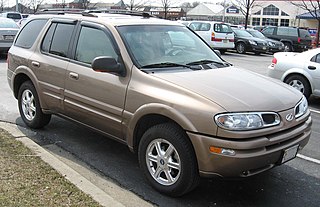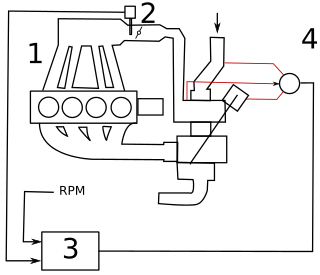
The Saab 900 is a mid-sized automobile produced by Swedish manufacturer Saab from 1978 until 1998 in two generations: the first from 1978 to 1994, and the second from 1994 to 1998.

The Chevrolet Impala is a full-size car that was built by Chevrolet for model years 1958 to 1985, 1994 to 1996, and 2000 to 2020. The Impala was Chevrolet's popular flagship passenger car and was among the better-selling American-made automobiles in the United States.

The Saab 9000 is an automobile produced by the Swedish company Saab from 1984 to 1998. Representing the company's foray into the executive car scene, it was developed as a result of the successes of the turbocharged 99 and 900 models. The 9000 remained in production until May 1998 and was replaced by the 9-5 in late 1997, although some final cars were produced into 1998. The Saab 9000 was only available with petrol engines, in two different 5-door hatchback designs or as a 4-door notchback.

The Saab 99 is a car produced by Swedish manufacturer Saab from 1968 to 1984; their first foray into a larger class than the Saab 96. While considered a large family car in Scandinavia, it was marketed as a niche compact executive car in most other markets. It was manufactured both in Sweden and Finland and was succeeded by the Saab 900, although the 99 continued to be produced alongside its successor. The Saab 90, an updated, less complex version using many 900 parts took over from the 99 in late 1984.

The Volvo 164 is a 4-door, 6-cylinder luxury sedan unveiled by Volvo at the Paris Motor Show early in October 1968 and first sold as a 1969 model. 146,008 164s were built before the car was succeeded by the mid-size luxury 264 in 1975, although some sources state 153,179 were built). The 164 was Volvo's first venture into the luxury segment since the end of PV 60 production in 1950, and was the first six-cylinder Volvo since the PV800 last produced in 1958.

A vacuum fluorescent display (VFD) is a display device once commonly used on consumer electronics equipment such as video cassette recorders, car radios, and microwave ovens.

A dashboard is a control panel set within the central console of a vehicle, boat, or cockpit of an aircraft or spacecraft. Usually located directly ahead of the driver, it displays instrumentation and controls for the vehicle's operation. An electronic equivalent may be called an electronic instrument cluster, digital instrument panel, digital dash, digital speedometer or digital instrument cluster. By analogy, a succinct display of various types of related visual data in one place is also called a dashboard.

The Oldsmobile Bravada is a mid-size luxury SUV that was sold by Oldsmobile from 1991 to 2004. The only SUV ever marketed by Oldsmobile, the Bravada was the first light truck offered by General Motors outside of the Chevrolet and GMC divisions since 1924. The flagship of the GM midsize SUV line, the Bravada served as the most luxurious GM SUV prior to the introduction of the GMC Yukon Denali and Cadillac Escalade.

The Buick Rendezvous is a mid-size crossover SUV that was sold by Buick for the 2002–2007 model years. It debuted at the Chicago Auto Show in February 2000, and sales commenced in spring 2001. The Buick Rendezvous and its corporate cousin, the Pontiac Aztek, were GM's first entries into the crossover SUV segment. The Rendezvous featured a four-speed automatic transmission with a V6 engine and optional all-wheel drive. The SUV used the same platform as GM's short-wheelbase minivans, the Chevrolet Venture and Pontiac Montana. The Rendezvous provided a passenger- and load-carrying capacity not seen in the Buick lineup since the discontinuation of the Buick Roadmaster Estate station wagon in 1996.

The Chevrolet Tahoe, and its badge-engineered GMC Yukon counterpart, are full-size SUVs and other trucks from General Motors, offered since 1994 and 1991, respectively. Since 1982, Chevrolet and GMC sold two different-sized SUVs under their "Blazer" and "Jimmy" nameplates, by introducing the smaller S-10 Blazer and GMC S-15 Jimmy for the 1983 model year, below the full-size Blazer and Jimmy models. This situation lasted into the early 1990s. GMC first rebadged the full-size Jimmy as the "Yukon" in 1991. Chevrolet however waited until 1994, when they rebadged the redesigned mid-size S-10 Blazer the "new Blazer," while renaming the full-size Blazer as the "Tahoe." The name Tahoe refers to the rugged and scenic area surrounding Lake Tahoe in the western United States, and was originally used as a trim level on S-10 models. The name Yukon refers to the Yukon territory of northern Canada.

The Subaru XT is a two-door, front- or all-wheel drive, four passenger 2+2 coupé manufactured and marketed by Subaru for model years 1985-1991, with a facelift in 1987. At introduction, the XT was the most aerodynamic car marketed in the US market, heavily influenced by noted designer Alex Tremulis.

The Cadillac BLS is a compact executive car that was marketed in Europe by Cadillac, sharing General Motors' Epsilon architecture, as a restyled variant of the Saab 9-3. Development was carried out by Saab and the car was manufactured in Trollhättan, Sweden, alongside the Saab 9-3 and the Saab 9-5. Sales of the saloon began in March 2006, with an estate joining the line for 2007. Starting in 2007, the BLS was sold in the Middle East, Mexico, South Africa and South Korea.

Automatic Performance Control (APC) was the first engine knock and boost control system. The APC was invented by Per Gillbrand at the Swedish car maker SAAB. U.S. patent 4,372,119

A tell-tale, sometimes called an idiot light or warning light, is an indicator of malfunction or operation of a system, indicated by a binary (on/off) illuminated light, symbol or text legend.

A trip computer is a computer fitted to some cars; most modern trip computers record, calculate, and display the distance travelled, the average speed, the average fuel consumption, and real-time fuel consumption.

The WM and WN series are the third and final generation of the Holden Caprice/Statesman, a range of full-size luxury saloons produced by the Australian manufacturer Holden from August 2006 to October 2017, sold primarily in Australia and New Zealand. They were also exported in various guises to the United States, the Middle East, China and South Korea. The range debuted alongside the smaller VE series Holden Commodore, which the Caprice shares its "Zeta" platform with, on 16 July 2006 at the Melbourne Convention and Exhibition Centre.

A defective pixel or a dead pixel is a pixel on a liquid crystal display (LCD) that is not functioning properly. The ISO standard ISO 13406-2 distinguishes between three different types of defective pixels, while hardware companies tend to have further distinguishing types.

The fifth-generation Subaru Legacy was originally unveiled as a concept car at the 2009 North American International Auto Show in Detroit to commemorate the 20th anniversary of the model, and the production version was introduced at the 2009 New York International Auto Show. Production of the fifth generation started on 29 May 2009.

The Subaru Tribeca was a mid-size crossover SUV made from 2005 to 2014. Released in some markets, including Canada, as the Subaru B9 Tribeca, the car derives its name from the Tribeca neighborhood of New York City. Built on the Subaru Legacy platform and sold in five- and seven-seat configurations, the Tribeca was intended to be sold alongside a slightly revised version known as the Saab 9-6X. Saab, at the time a subsidiary of General Motors (GM), abandoned the 9-6X program just prior to its release subsequent to GM's 2005 divestiture of its 20 percent stake in FHI.

The second generation of the Subaru Impreza compact car was introduced in 2000 and manufactured up to 2007 by Subaru in Ōta, Gunma, Japan, in both sedan and five-door Hatchback bodystyles, as well as two intermediate facelifts throughout its lifespan.





















